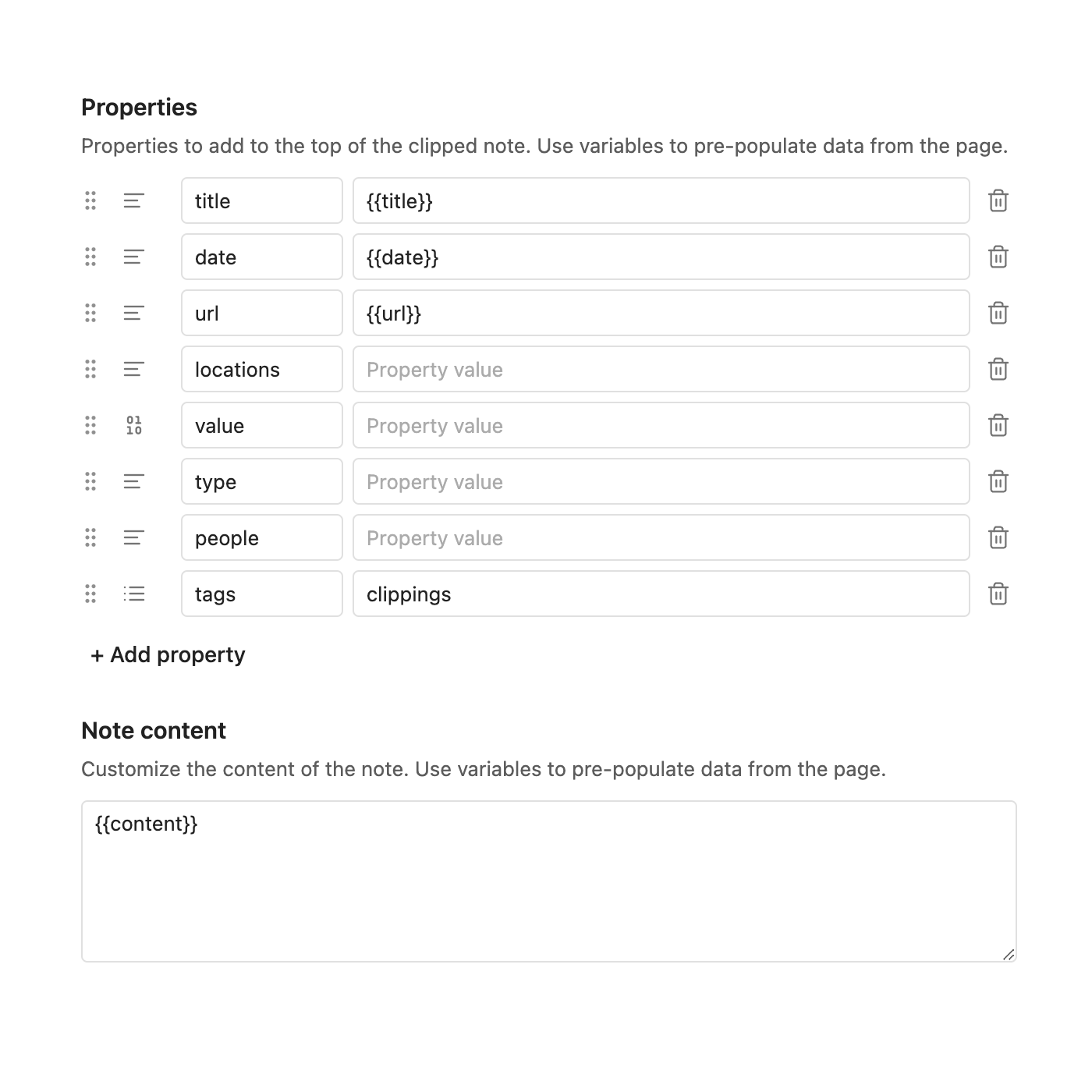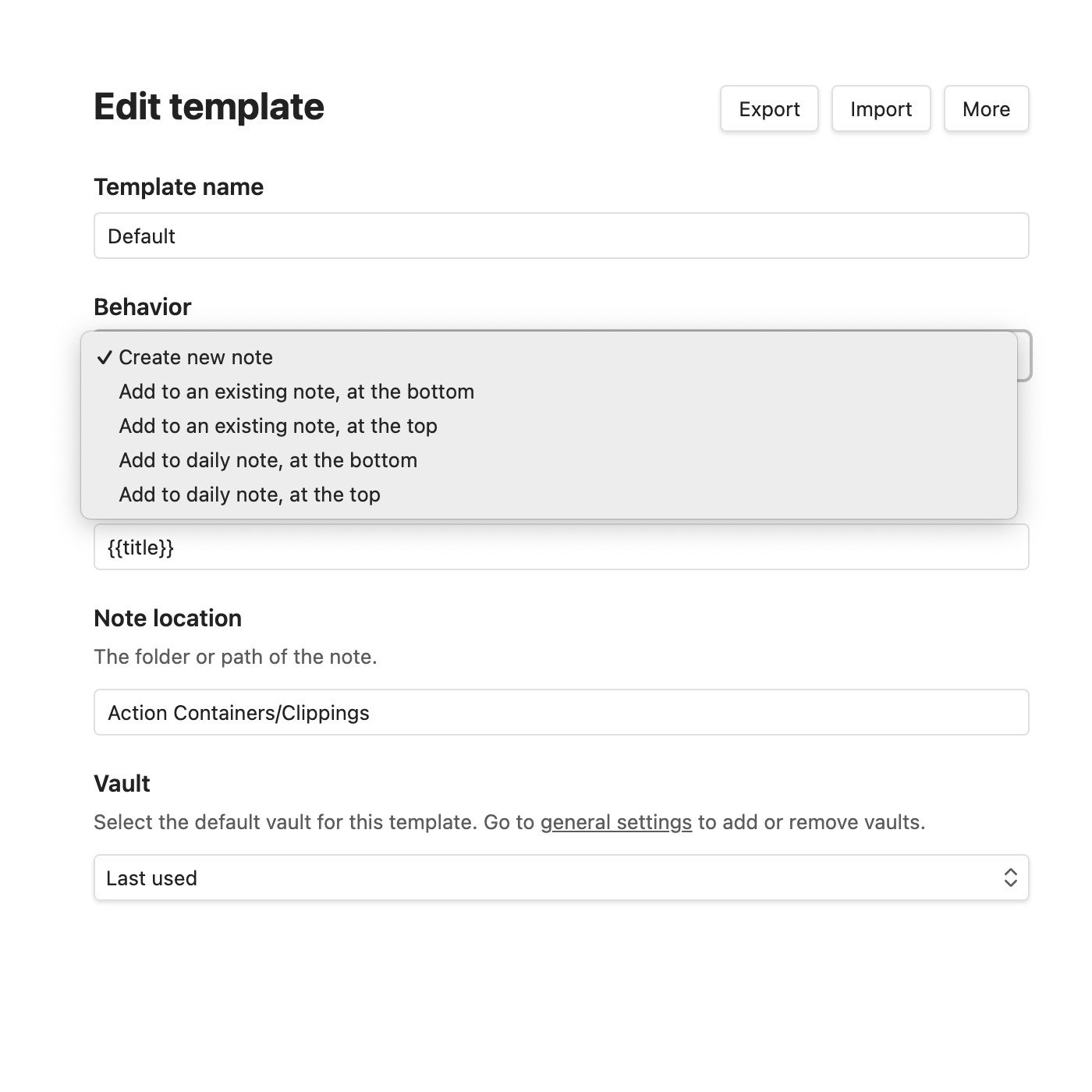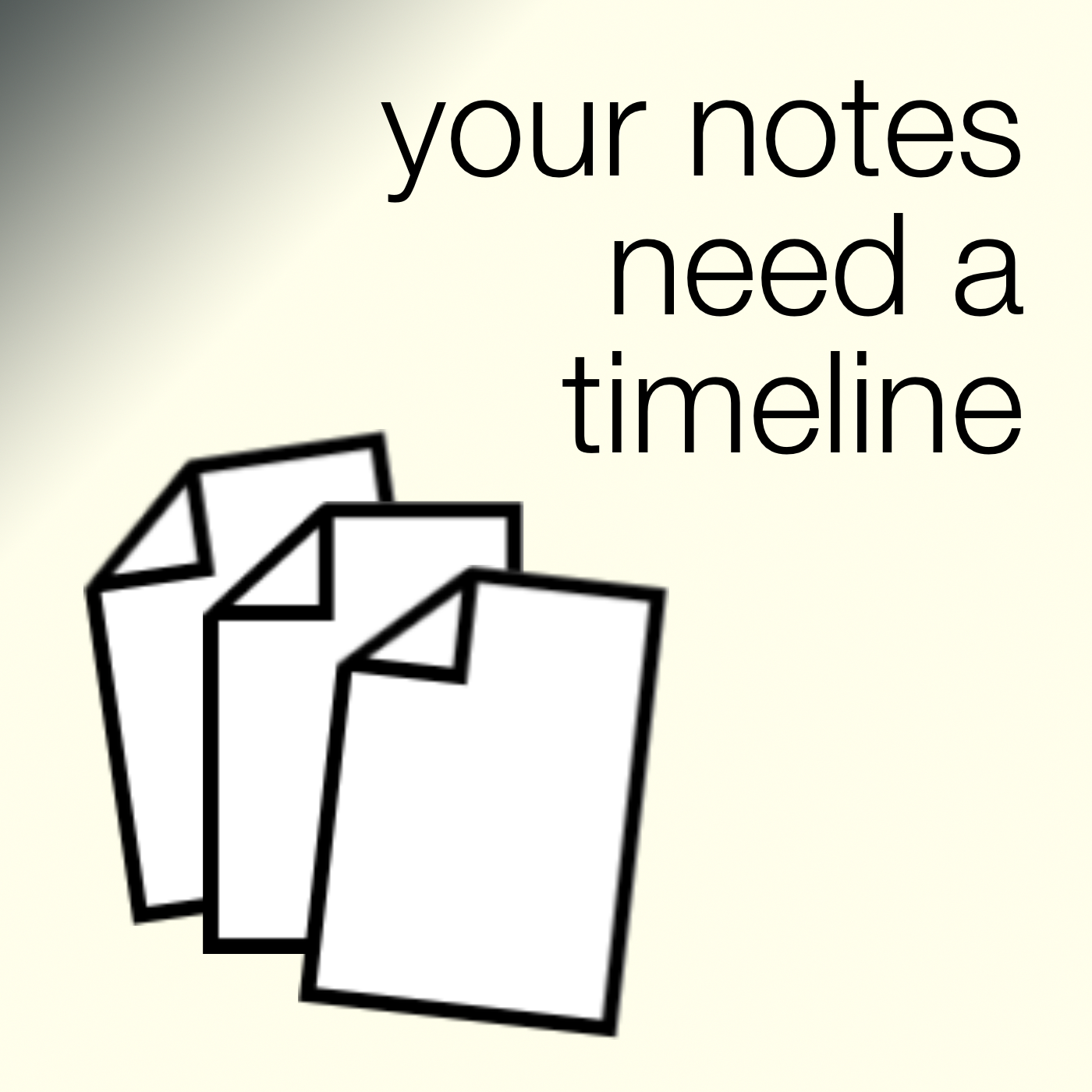Obsidian
Three everyday situations where the Timeline System in Obsidian can help you
What I love about the Timeline System is how simple it is to change the status of an activity by simply moving a note from one place to another.
A friend recently came up with a challenge. He told me he would like to know how I would use the Timeline System to organize and keep track of two everyday situations.
Bring it on, I said.
The first one was about a concert. He would like to know what I would do with the PDF tickets, that were incompatible with his phone wallet. Since this is still in progress, it should be in the Action Container.
I’m pretty sure there are other approaches, but this is how I would do it. In fact, I’ve done it before a few times, and it worked pretty well. I think of events like this as trip activities, even though it is happening in the city where I live. So, the Action Container would have a format similar to the one below.
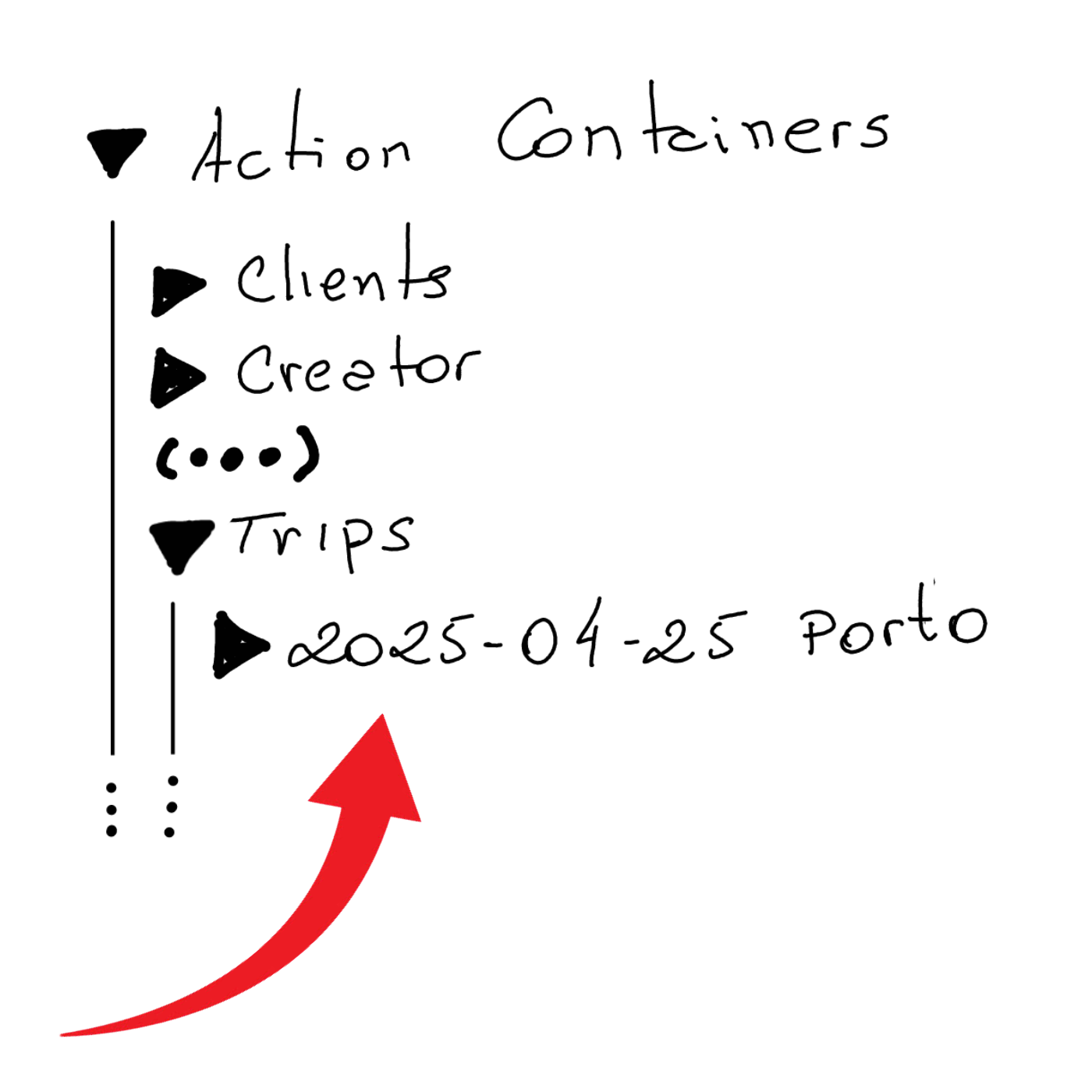
Where the folder ‘2025–04–25 Porto’ is the fake trip storing the concert tickets.
The other situation was an Amazon QR code he needed to show when returning a product. Since this one has no specific date, I’d simply keep it loose inside the Action Containers folder. Without a specific subfolder, it will be easier to find, and it will be an inconvenience working as a natural reminder every time I go to Obsidian to check my activities inside my Action Containers.
It’s a scenario very similar to what I’m currently doing (see video below) with the #Nadsat Glossary that I have to keep around to be able to read A Clockwork Orange.
What I love about the Timeline System is that all the above situations are notes that will eventually be moved to the Timeline container (folder). This will remove them from the list of activities in progress and, at the same time, keep them naturally organized in a place that I can go to retrieve information.
Another step towards repurposing my Obsidian vault
I have been testing the idea below for the past two months, and so far, everything is working wonderfully well.
I had to check the information before writing this post, but it’s been 16 years since I started using password managers. If you are not already using one, please share your secret with me. Given the huge number of passwords we have to deal with these days, they have become indispensable software. However, like many other apps, what was once a one-time fee became a subscription.
I don’t have any problem with paying, especially considering how they make our online presence safer while keeping passwords easy to manage. My issue is with losing control. Compared to a paper notebook kept in a drawer, it’s a much better solution, but our passwords are now sitting on a mysterious server somewhere in the world.
So, after testing the concept of a “digital cave” with many other items, I decided it was time to do the same with my passwords. But to accomplish that, I would need to find an app that keeps all the passwords in a single file, which I could then move to my vault in Obsidian. It would also need to have clients for all the existing platforms. And finally, it would be preferable if it were Open Source.
KeePass checks all the boxes above, and as you can see in the video below, I created the database inside in my Timeline and copied about 20 passwords to test the idea.
I’ve been playing with this configuration for a couple of months and since I’ve encountered no problems, I’m now looking for a way to import the remaining passwords.
If you’d like to try it too, watch the video. And if you know any other software that would also check all the boxes, please let me know.
A Clockwork Orange
I see A Clockwork Orange as part of a group where I also put Do Androids Dream of Electric Sheep, 1984, and others that depict this dystopian future that, for some reason, attracts me.
<img src=“https://eu.uploads.micro.blog/217685/2025/cover-a-clockwork-orange.png" alt=“Cover of the book A Clockwork Orange by Anthony Burgess, featuring a bold use of black, orange, and white with geometric shapes.” style=“width:150px; hight:auto; >
Even though I’m sure it would not be a good experience at all, for some unknown reason, part of me has a secret desire to experience this alternative reality in person. It’s not just the dystopian future that attracts me. I also love the future from the perspective of the 60s.
Back to the A Clockwork Orange book, if you need a tip to use the Nadsat Glossary, I suggest watching this video to learn how I set it up in Obsidian.
The vision I have for my Obsidian Vault needs a carefully planned explanation
I am delighted to see that the pieces of my Obsidian setup are starting to come together in this organic way. It seems like as I make small changes here and there, my progress gets stronger. In other words, the more I move forward, the less friction there is.
I’m doing my best to document this journey on YouTube and on my site, but the more it evolves, the more this idea that it needs a carefully planned explanation grows on me. I’m still halfway through writing my current book, but I’m already feeling the desire to write another one about how I’m materializing this vision I have for my Obsidian Vault.
And, speaking of the current book, it is taking its toll on me because I chose to write in English. I don’t regret my decision, but it is exhausting to think and formulate ideas in a foreign language.
Similar to my progress with Obsidian, my writing is getting more and more steam as I move forward, but that doesn’t change the fact that it is taking me much longer than usual to finish it. If I were writing it in Portuguese, it would likely already be published.
Well, I will get there eventually.
Have a lovely week, Vlad.
Obsidian as a writing hub
Scrivener and LanguageTool are remarkable tools that I use all the time, but they don’t have an Android App. Luckily, Obsidian works as an elegant bridge that has clients for multiple platforms.
Please allow me to begin by explaining the situation. I’m a Mac user who switched from the iPhone to Android many years ago and have no intention or desire to go back.
That said, I sometimes come across great writing tools like Scrivener and LanguageTool that don’t have an Android App. Thankfully, Obsidian is an important part of my writing kit and has clients for multiple platform. This is the story of how I use it as my writing hub.
Scrivener is where I’ve been writing my books since 2012. I don’t know how others create, but in my case, I usually start by writing down ideas as they come to mind. When there’s enough content and a lot of mess, it’s time to organize the text, and that’s probably my favorite thing about Scrivener. Coping and pasting is harmless, since the draft file has no formatted text, and it is also extremely easy to rearrange chapters by simply dragging them around.
Another crucial aspect of writing is grammar. For a non-native speaker like myself, a little help with synonyms and sentence construction is very welcome. That’s where LanguageTool shines. It feels as if I have an English teacher constantly suggesting changes to improve the text.
Don’t ask me why, but Scrivener never added support to LanguageTool, despite the existence of an API. So, even when using my Mac to write, I can’t benefit from both of them working together. And when I’m away from my computer, things become even harder because none of them have an Android App. That even affects the Supernote, as it is also an Android under the hood.
Thankfully, there is a way to connect all of these seemingly incompatible pieces. Several months ago, I shared a workaround for using Scrivener’s sync feature to have access to your book’s draft as Markdown files in Obsidian. You can learn ho to do it, by watching the video below.
Yesterday, you learned about another part of the puzzle. There is a LanguageTool plugin for Obsidian that uses the same API Scrivener could be using to make writers' lives more comfortable.
By combining both methods — synchronizing the book with Obsidian and using the LanguageTool plugin — we can create the perfect solution to use the spell checker when writing on a Mac or using an Android phone. Which also includes the Supernote. Isn’t that cool?
However, that is not all the writing I do in Obsidian. This article, for example, started as an idea in my Creator Action Container. The note was born there when I was riding the subway and wanted to write some ideas and drafts of a few paragraphs.
I kept working on it the next day, but this time I used Obsidian on my computer. In both cases, LanguageTool was there helping me. When it was finished, I moved it from the Action Container to the website folder to then make it available online, where you are reading it now.
If you’d like to learn more about all of these interconnected folders, please watch the video below.
These represent all the page connections through links or tags within my new website thus far.
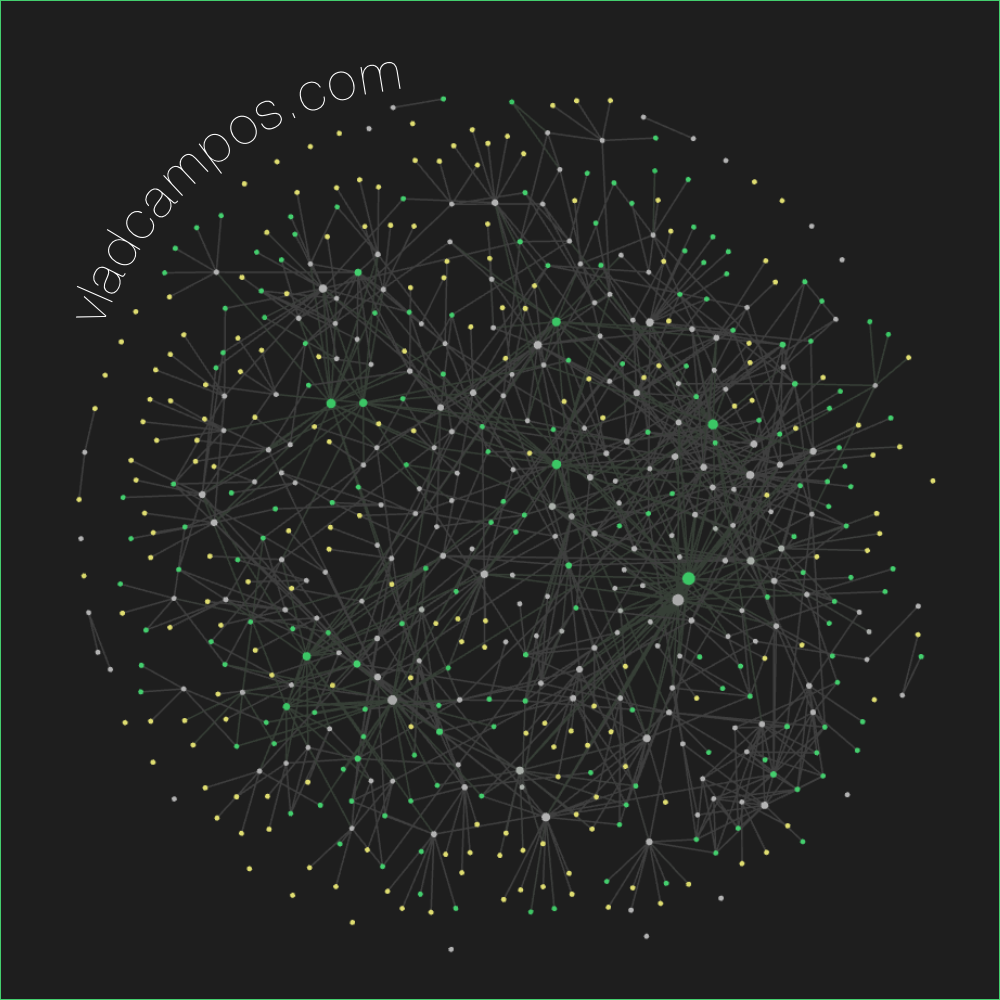 Create using Obsidian Graph View
Create using Obsidian Graph View
I have something new and exciting to show you!
Well, I’m not sure if you’ll find it exciting, but I’m thrilled about it.
Over the past few weeks, I have invested a lot of time into revamping my website so that I can share with you all my Blog posts and Knowledge Base in one place. Perhaps we can call it a Knowledge Base Blog. Hum, it looks like KBB would be a good acronym. Anyway, here’s what I’ve done so far.
Oh, by the way, you may be asking yourself why I’m also using Substack to share this post. This may or may not be temporary; however, due to the migration of my website to a different platform, I have lost the newsletter feature that I previously had. Anyway, back to my KBB
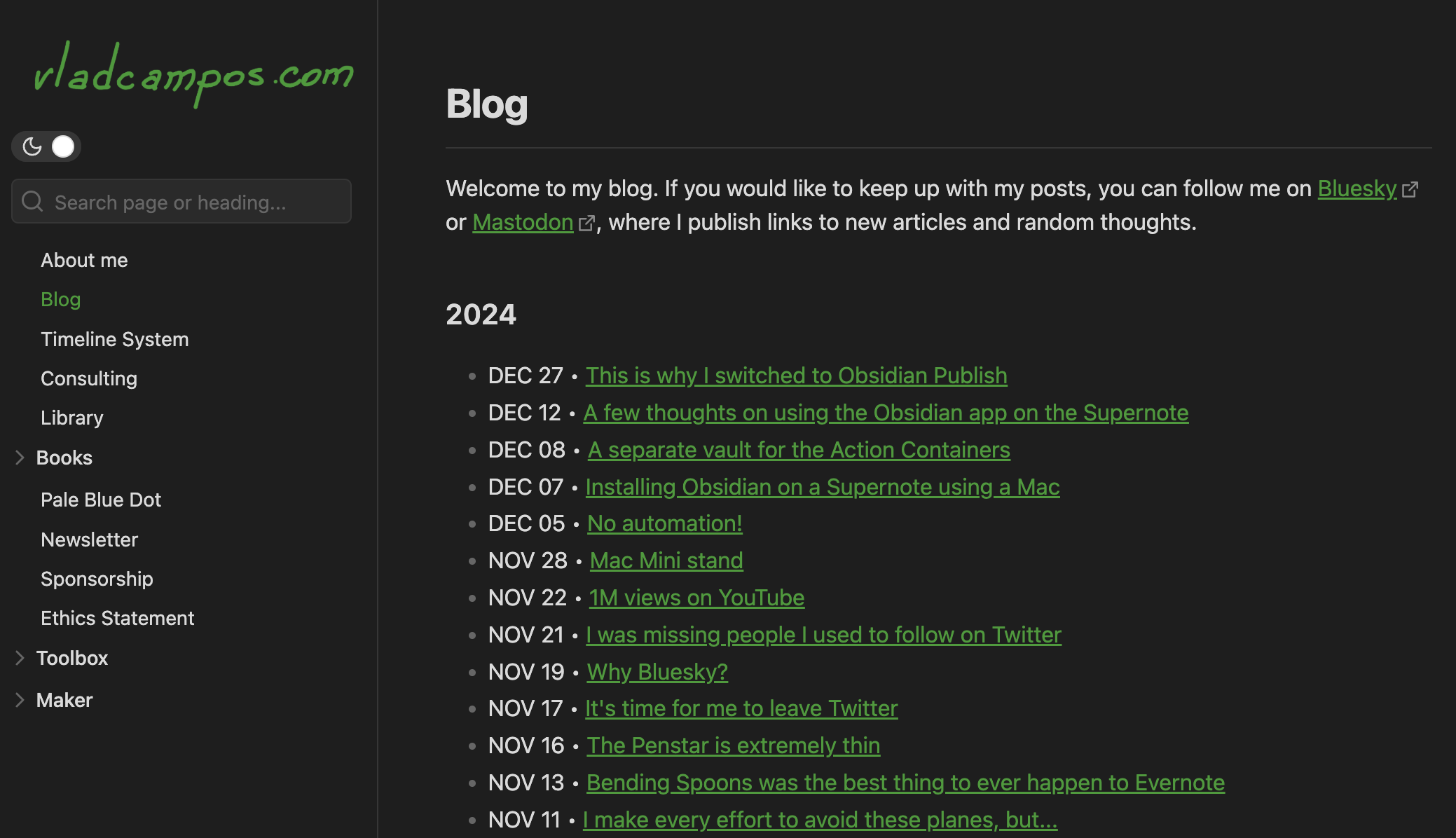
Let’s start with the left-side menu. Except for Books, the first group of items—from About me to Ethics Statement—are the same topics (pages) I already had on the other site.
Toolbox and Maker are where I’m exploring ways to share my Knowledge Base with you. As you can see in the image below, there are many topics, and each one of them contains explanations, how-tos, and other types of resources and information to help you learn more about those areas of interest.
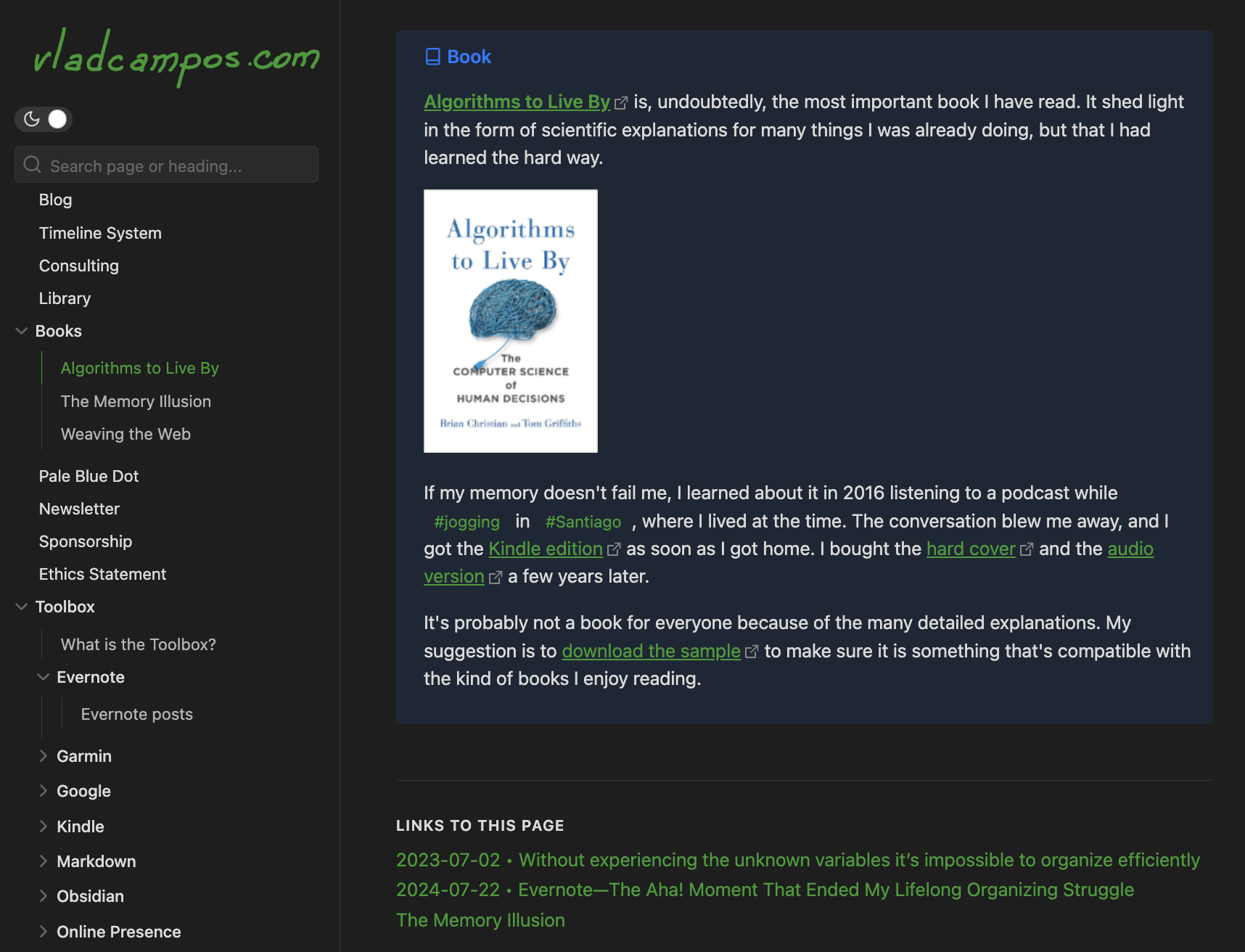
However, the cool part, at least for me, is how I’m connecting all that with the blog posts. Think of all the information as widgets I can add to any post. As a matter of fact, embedding them is part of what I’ve been doing for the last few weeks.
Let’s look at the Books section. For now, there are only three books there, but the idea is to keep adding them. The book Algorithms to Live By, for example, is a page with some of my thoughts about it. Anyone who wants to know what I think about the book can go to that page. But there’s another path to that same information. In fact, many paths.
You may be reading a post, like this one, with that same information embedded. In other words, every time I mention that book in a post, I can include that “widget”. And this is just the tip of the iceberg. There are several integrations like this all over the new website.
But there’s more. If you take a look at the bottom of the book’s page, you’ll see the Links to this page list. That’s an automatic compilation of all the pages mentioning that book. And if we go back to the Toolbox, each topic also has (will have) a page like that. For example, vladcampos.com/evernote, vladcampos.com/supernote, and vladcampos.com/voicenotes are automatic compilations of posts about those topics.
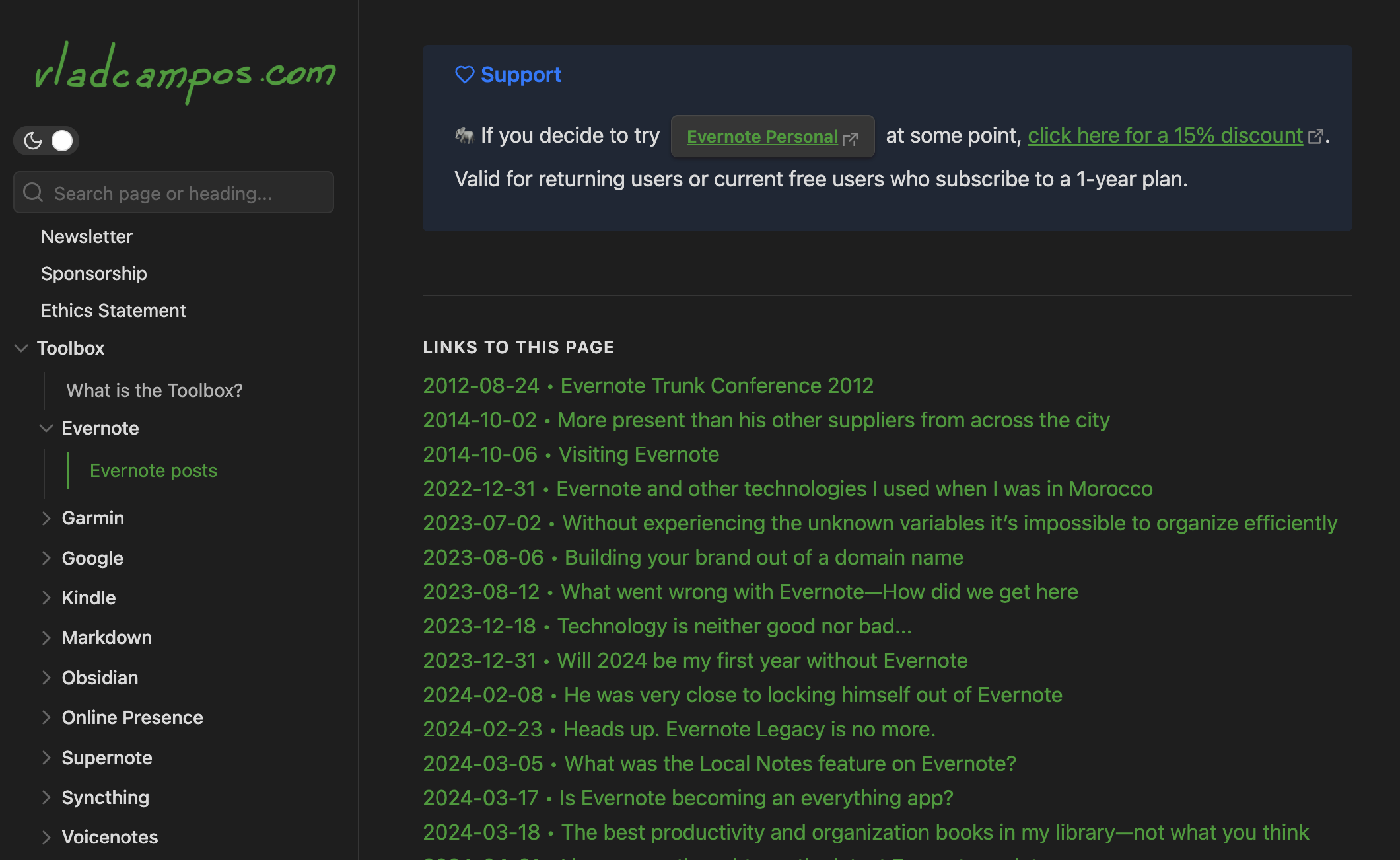
Don’t leave yet. There’s more. In many pages on the website, you’ll find words that start with hashtags. Those are tags, and clicking on them will open a list of other pages with that tag.
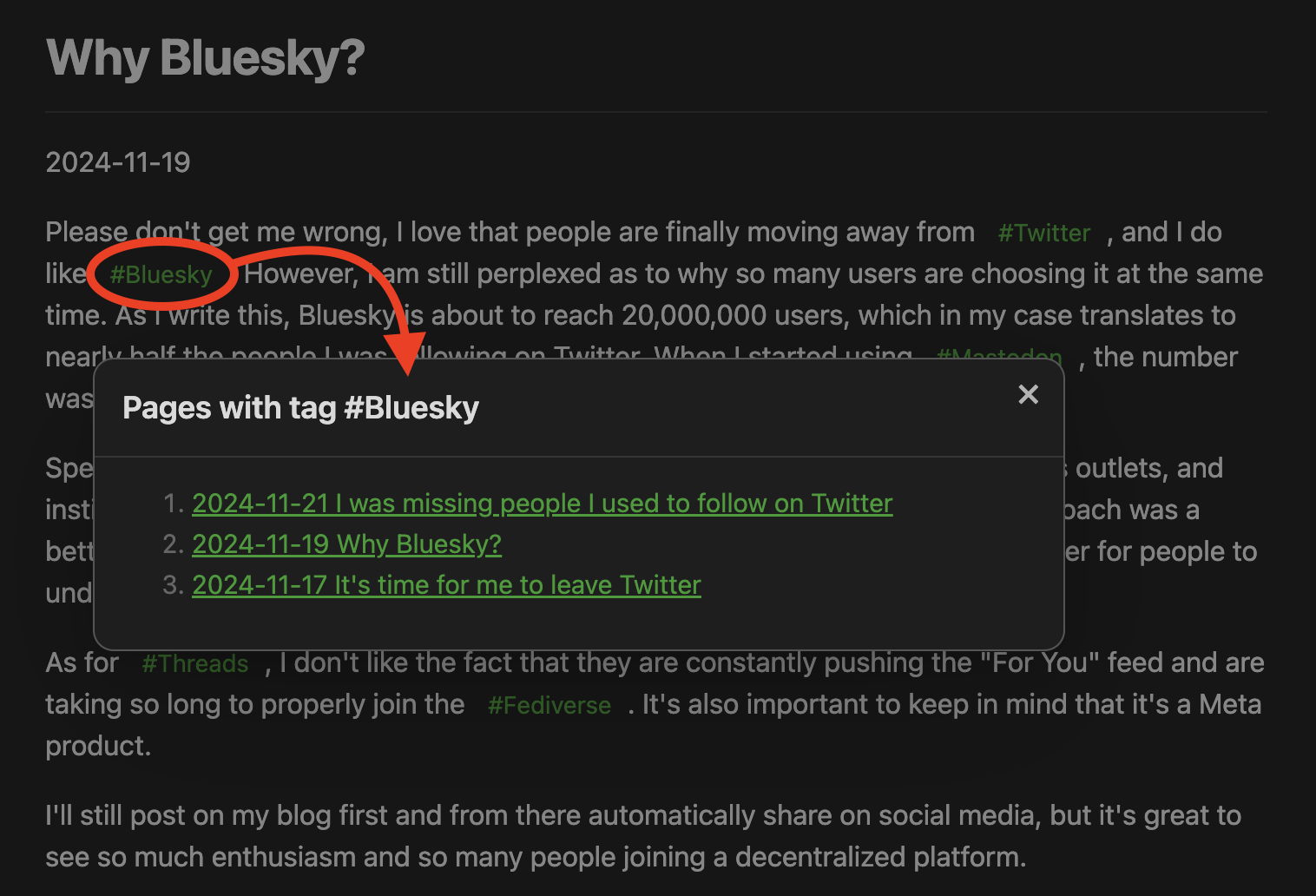
I am still working on many things, and the structure may change in the coming days or weeks, but the main goal is to keep connecting new content to this web of knowledge.
Back to Substack…
As you can imagine, this intricate structure is only possible on my website, and that’s why I have no idea how to “translate” it to a newsletter. But that is a problem I am leaving to my future self to deal with. For now, I invite you to explore my KBB.
I wish you a wonderful 2025 🎉
I still have a lot of work to do, but this first version represents the initial stages of my vision for a website that is both a learning center and a blog.
Obsidian Publish is far from perfect, and many of the issues I’ve complained about in the past, are still present. However, things changed on my side. I have gained experience, acquired new technical skills, and developed a deeper understanding of topics related to online presence.
Maybe all that helped me understand what my vision was. That’s probably why I now see Obsidian Publish as an appealing option.
A few thoughts on using the Obsidian app on the Supernote.
After a few days with the new Obsidian vault I set up for the Supernote, it’s time to discuss some other little tweaks I made and issues I experienced.
I still haven’t found a solution for the context menus that pop up when I hover the pen over clickable items. In the video below, you can see it happening on Obsidian, but it’s also affecting Syncthing.
At first, I thought it was linked to sideloaded apps, but it’s not happening to all the apps I installed, and I can see it happening when I’m using Obsidian on my computer. In other words, it appears to be a normal behavior found in certain apps, and I’ll have to investigate further to resolve this issue.
Battery
The battery is also draining faster than usual. It’s not something crazy fast, but it was bothering me, so I decided to try a different configuration. Syncthing-Fork has a setting to change the the number of synchronizations per day.
I hope it will improve the battery situation. The drawback is that I’ll have to pay more attention to the synchronization status, but I am fine with that.
Supernote Cloud & Tasks
Since we’re talking about sync, I went back to the Supernote cloud. In my opinion, it’s a better option, since I can see and manipulate files seamlessly on the phone and computer companion apps, where, by the way, I can also manage tasks.
I love how the Tasks app works seamlessly with notes, but there’s one thing that’s still driving me crazy. As you already know, I see Inboxes as a huge waste of time, so when a system has a folder like that the user cannot remove, I just ignore it. However, the Supernote forces me to use it.
On the Mac or Android companion apps, I can open a specific list and create takes there, but that’s still not possible to do that when creating tasks on notes.
Syncthing
Back to the sync topic, the one thing the Supernote cloud was not as efficient as Google Drive, was giving me quick access to my sketches exported to JPG or PNG. But, as I show in the video below, I’m now doing this using Syncthing.
I am still working on improving my workflow to efficiently combine what the Supernote and Obsidian do best, but I am already thrilled with what I have accomplished so far.
After installing Obsidian on my Supernote I can clearly see that the battery it is draining faster. It’s not substantial, like going down in a few hours or days, but it’s definitely draining a little faster. It could also be because I’ve been trying and testing so many new things lately.
There are some settings that I can change on Syncthing to improve the situation, but before I go that route, I’ll give it a few weeks under normal use conditions to see how it performs.
Stay tuned. I will keep you updated.
I ended yesterday’s video telling you I had an idea that got me really excited. Actually, it’s a plan that combines two visions into one. First of all, I realized that instead of doing all the complicated maneuvers to synchronize only my Action Containers, I could create and synchronize a new vault just for my Action Containers and keep everything else, including the Timeline, in the current vault.
When it comes time to move a file to the Timeline, I can do so using the computer file system. This will have no impact on the way the Timeline System works, and I may be able to come up with an automation in the future to move completed actions to the Timeline on the other vault.
The second part of the plan is to put this new vault in the Supernote SD card. This not only keeps me from using all the Supernote internal storage space with my vault, but also opens up countless possibilities. I’ll show some of them in more detail in an upcoming video, but here’s an example.
Imagine that I sketched a project on Supernote and wanted to add that to a note on Obsidian. In the past, I would have to synchronize the image using Google Drive, for example, then, on my computer, drag it to Obsidian. I can now do it right there on the Supernote.
It’s just a matter of exporting it as a PNG and saving it to the folder where my Obsidian vault is. This will make it instantly available to use on Obsidian, which, in turn, will also synchronize with my computer and phone. Mind-blowing!
Installing Android apps on a Supernote using a Mac
If you are a Mac user, it is not exactly a simple process to install Android apps on your Supernote, but it is totally feasible.
Before we start, I have some disclaimers.
I am not a developer, and I have only a rough understanding of what is actually happening when following the steps below. I’m simply sharing what I learned researching online. It worked for me, but you should always do your research.
As for the Android apps, please be careful with what you are installing. Apps downloaded from the Internet, known as APKs, are not being checked by the Google Play Store.
So, if you decide to follow the steps below, know that you are doing it at your own risk. And make sure you have a backup of your Supernote before starting.
If you are curious to see how Obsidian performs on the Supernote, I invite you to watch the video below. And if at some point you decide to purchase a Supernote, please consider using my affiliate link (clicking here). Thank you!
Sometimes doing things on a Mac is much harder than it is on a PC/Win. Today, I was finally able to sideload Obsidian onto my Supernote. Meaning that we’ll soon have some fun installing and testing the Minimal theme on it as well.
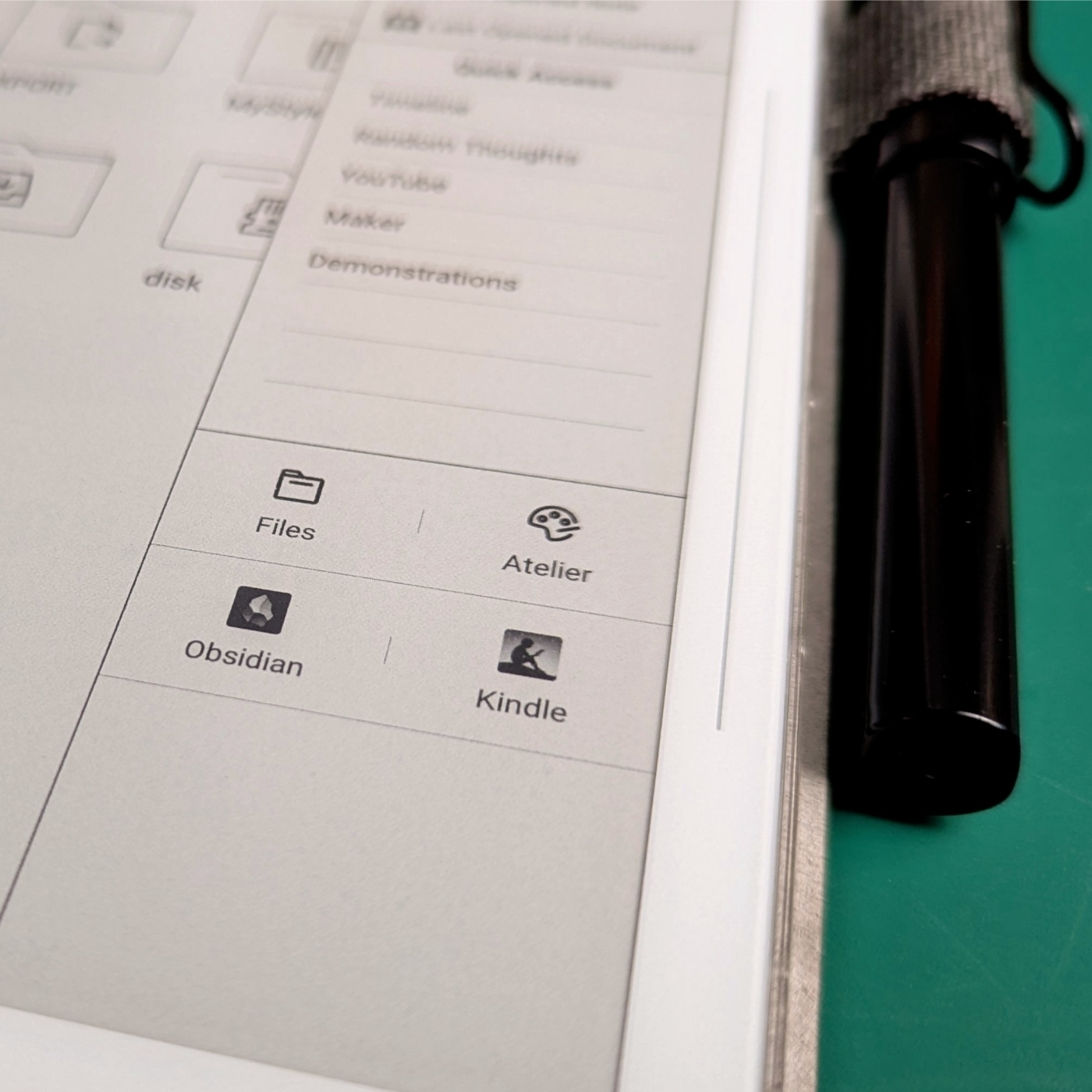
The Obsidian Minimal theme looks great on the Penstar. But that’s not all I’m showing in today’s video. Did you know that each device you sync with the same vault can have different settings?
The Penstar eNote is extremely thin, the screen resolution is impressive, and it feels as if I’m writing on paper. I’d say it might even be too realistic. But there’s more. It blew my mind when I could install Android apps by just clicking on the APK.
I installed both Syncthing and Obsidian on the Penstar eNote and my notes are now synchronizing 🤯 (for now, only on my tests account). You’ll see it in the second part of today’s video. The first part is a quick demonstration of some of the device’s features.
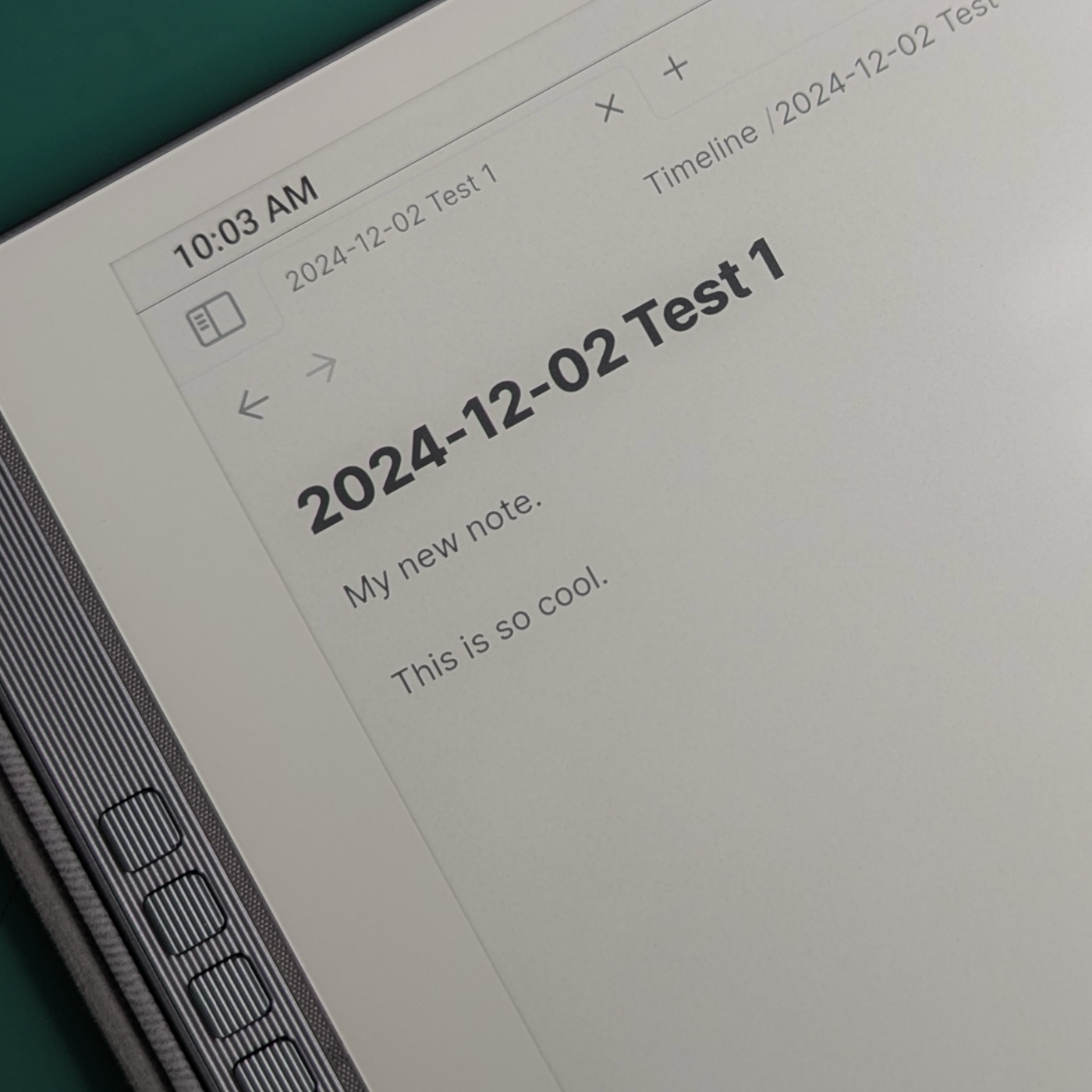
I added the Gemini Flash API, but keep getting the “Missing Authentication header or invalid API key” message when I try to use the new Obsidian Interpreter. As a non-developer, I have no idea what an “Authentication header” is, so I’m switching to another project to refresh my mind.
At times, the smallest of things can bring us the greatest joy. The Obsidian Web Clipper is great, but the fact that we can set it to always show highlighted text when we return to a webpage is such a nice touch. I 💜 it!
There are a lot of configuration options in the new Obsidian Web Clipper. And I love it! For example, I set it to create the clipped note with the properties I always use. But there are many other options, such as choosing between creating a new note or adding to a specific position in an existing note. Anyway, it’s going to take me some time to test everything and then make a video about it.
